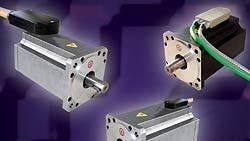A new series of connectors from ITT, the CmX family, reduces the cost, weight, and size of conventional circular servo motor connectors. It also combines and isolates power and signal lines within a single connector, eliminating the need for separate circular connectors for these functions.
A servo motor has three main sub-components. The first is the motor itself, typically an ac motor or a brushed-dc motor. The second is a resolver or rotor-position encoder for detecting the precise angle of the servo motor shaft. The third is the pair of power and data connectors. In addition to these components, servos may also include a thermal sensor and a mechanical brake.
While there is a trend to reduce the size of the first two main components, the size of the connectors has remained essentially unchanged, limiting the ability of motor manufacturers and their end-users to reduce total form factors. According to Olivier Miller, Director of Strategy and Business Development for the worldwide industrial market, this is a significant problem, because servo motors are the highest-volume components in the industrial market.
The CmX connector family, shown in Figure 1, is specifically designed to address this problem, based on feedback from the industry. Miller estimates that weight, cost, and size of the CmX family are all reduced by approximately 50% compared to circular connectors.
The reduction in the connector’s size enhances servo applications by reducing the overall servo form factor. For example, the new connectors have already found use in the final two articulation motor stages in a precision industrial robot. This kind of precision and miniaturization benefits the manufacture of textiles, flat-screen TVs and other space-constrained processes.
In addition to reduced form factors, Miller stated the connectors provide other mechanical properties, such as superior and miniaturized strain relief for the motor cable, and compliance with the IP67 sealing-grade standard. This standard requires that the connector withstand a fluid immersion down to one meter for as long as one hour, which is important for the canning and other fluid management industries. ITT is also exploring other capabilities for this connector family, including support for RJ-45 cables and fiber-optics.
As shown in Figure 2, the connector housing provides isolation between the control signal connections (blue, red and yellow) and the power connection (black). The housing also secures the cables and their connectors, and seals the entrance openings to provide waterproofing.
Three main products in the family are the Cm2, the Cm3 and the Cm5. These connectors are rated for 3 A (48 Vac) or 10 A (630 Vac), 18 A and 30 A, respectively. According to Miller, many customers place more emphasis on the use of this connector than on the performance of the motor itself during the servo selection process.
